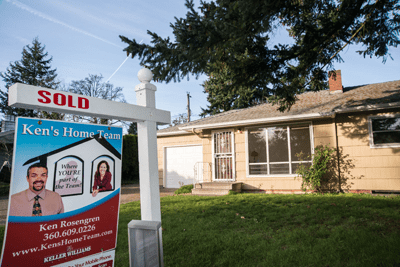If all houses were identical, understanding Clark County’s housing market would be easy. Look at how many homes sell in a month, how much they go for, and you’d have a quick snapshot that would tell the whole story.
And what a story it would be: Through this October, 4,999 homes have sold this year – a 5.6 percent climb over the same months in 2011. The median price of those homes was up 11.3 percent from October 2011 to last month. And listings spent less time on the market than a year earlier as well, according to real estate listing data presented by Mike Lamb, associate broker with Windermere Vancouver. Looks like an industry climbing fast.
But not all houses are identical. Take a closer look at nuances of the marketplace, and it becomes clear that the mid-2000s real estate collapse is still shaping home sales, prices and construction across Clark County today.
People who opted to rent after the housing bubble burst are increasingly choosing to buy, pushing up sales of “entry-level” homes, said Kelly McDonald, manager at Clark County Title. But demand for homes still appears to remain well below the levels seen in the 1990s and pre-bubble early 2000s.
A shortage of supply – available homes to buy – may as responsible as growing demand for pushing up prices in recent months.
For the past three years, few developers have been building homes from scratch, said Dustin Klinger, a Miller Nash attorney who specializes in commercial real estate. Many developers could not get financing to develop new subdivisions, or didn’t try because they didn’t find it financially feasible to compete with bank-foreclosures sold at deep discounts.
However, Klinger said, that’s beginning to change.
In October, developers obtained 61 permits to build single-family homes in unincorporated Clark County, up from 33 a year ago, according to the county’s Community Development Department. Building is still about a third of its pre-crash levels, but the trend toward more construction is clear.
“New construction is coming on strong right now because of a shortage of inventory,” said Nathan Cano of Cano Real Estate in Vancouver. “Good inventory is getting multiple offers.”
Cano said that about half of the 200 home sales he expects to close this year will be new construction. At an entry level Ridgefield subdivision, where properties are priced at $200,000 to $250,000, his firm is selling about two homes per week.
New homes are sometimes easier to sell than pre-existing, and a shortage of new houses is helping to push up prices, but it all depends on the quality of the house.
“It’s like going to the Nordstrom sale. If you show up on the last day, there may be stuff that’s a really good price you wouldn’t want to buy. Good inventory is getting multiple offers,” Cano said. “We’d be selling a lot more houses if there was more inventory in the marketplace.”
Instead, the inventory of homes for sale has been shrinking – it’s down 6.9 percent over the past year, according to RMLS figures for Clark County. And the actual inventory of existing homes for sale is likely even lower, Cano estimates.
“Inventory is officially at about four months,” he said. “Of the houses that are for sale – about 1,700 – 400 or 500 are proposed houses. They are just using a rendering of a house to market to buyers to get leads. If you pull out what we call ‘fake inventory,’ we get down to a couple of months’ worth of houses.”
Industry watchers agree that housing supply is currently below demand, which is pushing up prices – especially among entry level homes. But some are concerned that high foreclosure rates of recent years could threaten the current recovery. Banks own about 4,500 foreclosed properties in Oregon and about 7,500 in Washington. If all those houses were put on the market at once, the flood could hurt prices and cause a shock to the still-early recovery.
Fortunately, shadow inventory, as it’s called, is becoming less of a risk, according to reporting by Marketplace, which found that an improving housing market, smarter banks and a growing economy are helping to address the risks posed by foreclosed housing.
S&P/Case-Schiller, one of the most respected national sources of housing data, reported on Nov. 27 that properties in the Portland-Vancouver metro area are selling for 3.7 percent more than a year ago.
“We are entering the seasonally weak part of the year. Despite the seasons, housing continues to improve,” David Blitzer, chairman of the index committee at S&P Dow Jones Indices, said in a Wall Street Journal MarketWatch report. S&P/Case-Schiller concluded that the U.S. is “in the midst of a recovery.”
McDonald at Clark County Title cautiously echoed that conclusion.
“I don’t’ think we’re going to see a big spike in home prices any time soon, but they are headed in the right direction,” he said. “It’s the basics of supply and demand. Inventory is low, money is cheap and there are plentiful buyers. With the employment picture here hopefully getting rosier – with PeaceHealth, Fisher Investments and some others – hopefully it will continue to pick up.”




